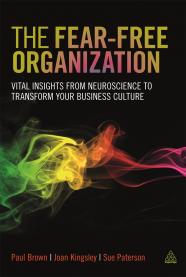The Fear-free Organization
Vital Insights From Neuroscience to Transform Your Business Culture


Prof Paul Brown is a clinical and organizational psychologist and executive coach. Joan Kingsley is a consultant clinical and organizational psychotherapist. Sue Paterson is an and gas business professional.
There are eight primary emotions, somewhat similar to primary colours, from whch all our emotional behaviours are triggered. Five of those (fear, anger, disgust, shame and sadness) trigger some fight or flight response; only to produce attachment responses (excitement/joy and trust/love); leaving surprise balanced between the two. By managing fear out of your organization you can take a big step towards better performance.
"Fear continuously triggers the corrosive [neuro]chemical cortisol" says Brown in the introduction to this book, and as with most things, anything in excess is usually a problem. In small doses cortisol will wake us up and direct attention, but too much of it and it becomes destrys brain cells, accentuates stress and damages the immune system.
Fear is probably the most easily used management tool, even though its use is ultimately detrimental to a sustainable organization. Any organization driven by fear will ultimately implode.
Central to this book is the idea that fear is instantly triggered by events, but individuals in most organizational contexts should listen to their calmer, slower thinking than their amygdala-driven instant reactions. "Dangers do lurk in organizational corridors. But they are the kind that are best dealt with by clear thinking and calm emotions that have been integrated with thought…with intelligent emotions."
A major chapter of the book focuses on the often overlooked importance of energy for the brain and how that impacts behaviour. The authors explain that the brain uses energy as raw wattage, that sends the tiny electrical pulses through the brain, that is fuelled by food and oxygen; and the motivational energy that makes us want to act, that is fuelled by emotions, or e-motions, as they put it. The brain whilst hugely energy efficient in comparison to a computer, uses some 20-25% of all the body's energy, despite accounting for just 3% of its weight.
The brain is 'always on', with the background activity using some 60-80% of the organ's energy usage. This 'default mode network' or DMN, helps organise memories and 'sense-make' our surroundings. It does much of this work while we are asleep. The DMN gets toggled off when we are focused on a task,when the 'task positive network', or TPN, clicks in. Both use around the same amount of energy. So whether you are focused or asleep your brain is needing energy, and if it does not get sufficient it operates sub-optimally.
At the heart of the book lies the e-motion focus. People act because they have an emotional urge to do so, and are prevented from doing so by emotions too, the authors suggest. The most effective demotivator is the titles 'fear'. The brain reacts dramatically to fear, shutting down the creative parts, preserving energy for just survival interests. We perform better at cognitively demanding tasks when the attachment emotions, love/trust and excitement/joy, are in play however.
The authors state “the management of energy, organizationally, is the management of emotions” and that is the vital truth that all managers need to be constantly aware of.
This is a revelatory book that shines a light on why we behave in the way we do.
Title: The Fear-Free Organization: Vital Insights From Neuroscience to Transform Your Business Culture
Author/s Name/s: Paul Brown, Joan Kingsley, Sue Paterson
Publisher: Kogan Page
ISBN: 978-0-7494-7295-5
Publishing Date: July 2015
Number of Pages: 215
Author Knowledge Rating: 1-5 (based on their years of experience, academic expertise in subject areas, and exposure to cross-functional thinking in the area)

















































































Readability: 1-5 score(1=dense and v academic; 5=frantic; page turner)


















































































Appropriate Length: (1=could have been written in 25% of the length;5=could have been longer)




































































































Core Idea Value: (1=nonsense (or entirely esoteric); 5=game-changer)



































































































